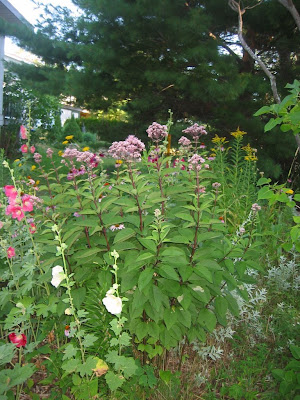 |
| LANDSCAPE PLAN FOR A CONTEMPORARY HOME ON A WOODED LOT |
 |
| BACK OF HOME |
 |
| FRONT OF HOME |
 |
| ON A TOTALLY WOODED HILLSIDE |
Monday, 8:45 AM. 63 degrees F at the ferry dock, 60 on the back porch. Wind variable and calm, the sky mostly cloudy but clearing, humidity 85%. The barometer is falling, now at 30.06" We may get some rain today, but the forecast calls for clear skies and temperatures in the mid 60'sfor the week ahead, with rain on the weekend.
I recently completed a landscape plan for a large contemporary home located on a densely wooded bluff just outside of Bayfield. I thought readers of the Almanac might be interested in the plan as it features native plants in a wooded environment and has a number of obvious challenges, including very steep hillsides and a dense forest environment. The plan includes a dry creek bed and stone retaining walls, the costs of which are not included in the plan estimate below.
PLAN INFORMATION
According to owners wishes, all plants and seed mixes are
native, except no-mow grass immediately around residence (5’-8’ width) to discourage
pests. A few plants may be nursery
selections of native species, and fescue and rye grasses used as cover crops
and transitional plantings.
The plan cannot be
considered absolutely true to scale because of distortion caused by
enlargement, and the plan, as is always the case, must be adjusted at planting
time.
The costs are
estimates, and do not represent a final bid price.
PLANT LIST: NUMBERS AND COSTS (retail)
1
MEADOW
ROSE Rosa blanda #1 pot,
30 @ 60= 1,800
2
BLUEBERRY Vaccinium
(native selection) #2 pot, Appx. 25 @ 30=750
3
SHADE GRASS AND FERNS (creeping red fescue seed
and native ferns)
$750 + or -
4
JUNEBERRY Amelanchier x grandiflora #7 pot, 3 @ 30=90
5
SUMAC Rhus
typhina @2pot, 20 @ 35=700
6
MEADOW GRASSES AND WILDFLOWERS (seed mixes)Approximately
meadow seed mix and excelsior mat
covering , approx.=$1,000
7
BALSAM FIR Abies
balsamea 5’B&B, 1 @ 350=350
8
BASSWOOD Tilia
americana #15 pot, 1 @ 170=170
9
ROUND LEAVED DOGWOOD Cornus rugossa 10 @ 30=300
10 HEMLOCK
Tsuga canadensis #5 pot, 5@ 60=300
11 WILD
HONESUCKLE Diervilla lonicera #2 pot,
5
@ 30=150
12 SNOWBERRY
Symphoricarpos alba #2 pot, 5@ 30=150
13 TAMARACK Larix
laricina #15 pot, 1 @ 170=170
TOTAL COST PLANTS AND SEED, ESTIMATE=6,680
INSTALLATION LABOR,
ESTIMATE=4,000
PLANTS, SEED AND LABOR TOTAL ESTIMATE=$10,680
Estimates do not
include state and county sales tax of 5+%, nor additional grading, top soil or
installing dry creek bed and walkway, which must be done prior to
planting. Once site work is completed
seeding and planting is best done in cool weather in September; otherwise in
spring.
I deal with
Northwoods Nursery in Rhinelander, WI, which is wholesale to the trade, and
with Prairie Nursery of Westfield, WI, for seed and roses, they sell retail and
wholesale. Excelsior fiber matting is
available from Brock White Construction Materials, Duluth, MN.
If you bid out the
job I would be available for on-site consultation regarding dry creek bed and
walkway layout and supervision.
Art Ode
August 1, 2017




























































